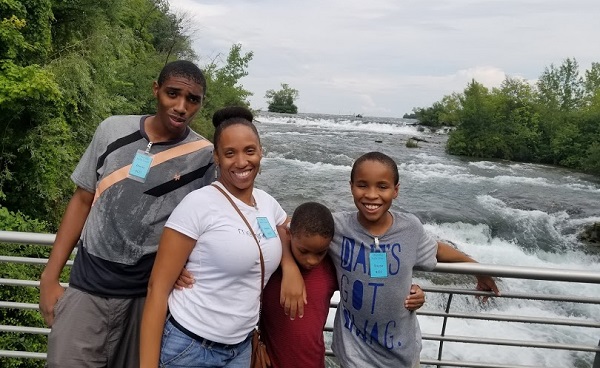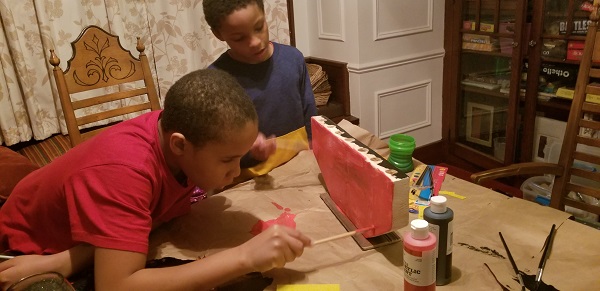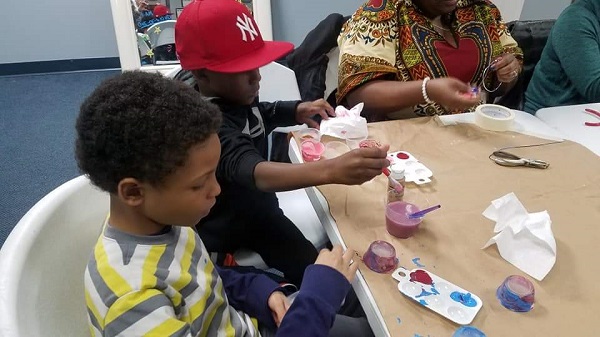
Considering homeschooling? Check out this mom’s guide to Pittsburgh education options
Photo: Muffy Mendoza and her sons, Jair, 18, Mackell, 12, and Phillip,11.
This story was first published in 2020.
In the wake of the latest Covid wave, parents are once again considering school options for their kids.
Homeschooling, unschooling, virtual and distance learning have become more than buzzwords that define how we choose to educate our kids. They are the means that will determine our lifestyles over the next year or two.
As a homeschooler for the past five years, my social media inbox has recently been full of parents wanting to know what the heck is homeschooling? How do schools plan to deal with moms and dads who work full-time and need to do virtual learning with their children? And they are wondering whether or not unschooling is something that will lead to their child’s success.
With years of homeschooling my kids full-time, I can unequivocally say:
- Your kids don’t need you to know nearly as much as you think they do.
- Good teachers are truly gems that we should all learn to appreciate with our gestures and wallets.
- All learning MUST be suitable to a child’s learning style and learning abilities.
I know that many of you may feel lost. I mean, this is a big decision to make, and it tends to take a lot of bandwidth to understand how homeschooling differs from school-at-home and how unschooling may or may not be just letting your kids run wild.
With that said, here’s a mini-breakdown of the modes of learning to help you make the right decision for your kids. Just remember that your choice should be just as unique as your child because each really is one in a million.
What is homeschooling?
Homeschooling is the physical act of removing your children from your local school system. Homeschooling requires a legal contract between a homeschool supervisor (typically the parent or caregiver) and the school district to be responsible for the education of the child.
Homeschoolers in Pennsylvania are legally required to do three things each year:
- File a homeschooling affidavit for all the children in your household, along with a list of educational objectives for each child, with your local superintendent’s office during August preceding the school year. For us, that would be the Student Achievement Center. I have all the documents you need on my website, brownmamas.com.
- Have your child tested when they are in the 3rd, 5th and 8th grade with a nationally recognized test. Many parents used Standford 10, which can be done online.
- Create a portfolio that includes a reading list, samples of your student’s work and an attendance log throughout the school year. Have the portfolio evaluated by a PA certified teacher, who will give you an evaluator’s form that should be filed with your local superintendent’s office during June at the end of the school year.
These documents can be filed as is, or you can adjust them to your educational objectives or needs. The most important thing to remember is that in the state of Pennsylvania, our government does not tell us how to educate our kids or the standard in which to educate them. They simply want to see that your child is progressing in a manner that is appropriate for their age and learning ability.
Many parents pull their kids out of their local school district and choose to homeschool as a step toward rejecting the idea that learning only takes place in the four walls of a classroom. However, during the COVID-19 pandemic, you might have an entirely different reason for homeschooling.
That’s OK. Just remember that it’s a rocky start for many people who choose this lifestyle. The good news is that homeschooling will give you a lot of time to spend with your kids. Many enjoy the opportunity to travel during the school year and move learning into your community and the wider world.
In truth, most homeschoolers do more hybrid learning than schooling-at-home. The Pinterest-esque image of homeschoolers in a poster-laden classroom reading Shakespearean poems while children eagerly raise their hands is false.
In reality, homeschool parents rely on online classes. Families have days when no one takes off their pajamas and movies are lesson plans. We do algebra with tutors or multiplication at the grocery store. And we take a lot of trips.
The world is our classroom and sometimes takes on a distance learning-feeling similar to what many parents and students will experience this year. But most days, homeschooling takes on a life of its own.
Distance learning (cyber school)
Distance learning is when children utilize virtual interaction as the primary means of being educated by adults. That means they might engage with their teachers, peers and other school administrators via computer rather than in-person.
My sons did one year of cyberschool when we first started homeschooling. We quickly pulled them out because it was too much screen time for us. However, I’ve seen many parents utilize cyber school as a real means of homeschooling and still garner the socialization and community participation necessary to raise well-rounded, happy, healthy adults. Many single parents use cyberschool as a way of homeschooling while maintaining their work schedule.
One of the perks of distance learning, unlike in-person schooling, is that schoolwork can be completed at your child’s own pace. Most cyber schools have weekly deadlines that kids must meet, but they can take the entire week to complete their work. Unlike kids in many in-person, underserved school districts, this still leaves time for parents to take their kids on field trips and for them to interact with friends.
Cyberschool removes the need for parents to facilitate education. Most distance learning platforms include interactions with teachers who guide the children in their assignments and are available for instruction and assistance.
Distance learning can be done at the behest of school districts, too. One example is the distance learning option that Pittsburgh Public Schools are offering students in the wake of COVID-19.
Distance learning can also be done using an online charter school, like Community Connections or Agora Cyber. Online charter schools are usually free-of-charge and all materials and supplies are provided.
Another option is online private schools that charge a fee, like Calvart Academy. They are similar to online charter schools, but promise a superior educational experience.

Unschooling (or self-directed learning)
Unschooling was founded by Professor John Holt, who, after teaching in a private school, discovered that children possess the ability to pass tests in school environments, but don’t retain much of the knowledge. Unschooling puts the onus on kids to lead their own learning experiences through their need to quench their curiosity.
Unschooling was born out of this concept and later developed into the self-directed learning movement, which asked parents to reevaluate schooling as a vehicle for learning and pushed them to lean on their child’s inquisitiveness.
In short, unschooled parents only teach when the student is ready. The philosophy follows the African proverb: “When the student is ready, the teacher appears.” Parents co-create optimal learning environments when their kids request opportunities to learn. For example, unschooling parents might take their kids to a bug convention when they are curious about ladybugs. They might spend an afternoon exploring a neighborhood or city, allowing their kids to choose what they want to see. They might question their kids on how they can act as better facilitators or give them access to a new experience.
Unschooling parents typically don’t spend time on teaching specific curricula or standards, nor do they dish out assignments with deadlines. But I have heard of some unschoolers who require their kids to do basic math and reading early.
Just like homeschooling, unschooling is more about deschooling. That is, removing the need to perform and inserting the internal desire to learn as the primary means for education.
A lifestyle shift
All these modes of learning and ways of living are different, for sure. If you choose to go one of these routes, the most important thing to remember is that when your children are home with you 24/7, it causes a lifestyle shift. And hopefully, you’ll develop a mindset that is more closely in line with your child’s own need to learn.
At first, it will be not only challenging but also overwhelming. Some days, you are going to want to ship them back to school. Other days, you will see the glimmer in their eyes and their excitement being with you, and you’ll want to kiss their face off.
My first years of homeschooling were just like this, but today I wouldn’t have it any other way. That’s coming from a mom who, in her 20s, never saw herself being married, let alone homeschooling a gang of little boys.
Just remember, we are in the midst of a continuing pandemic. If your biggest problem is your kids being with you all day, I’d say you’re doing pretty good.

